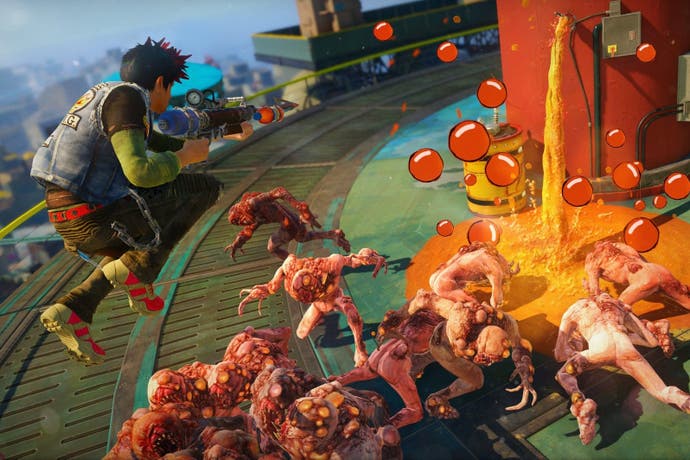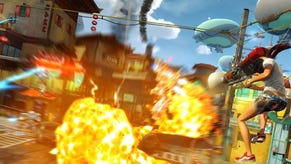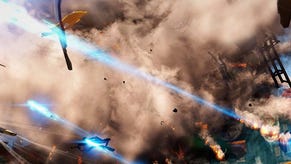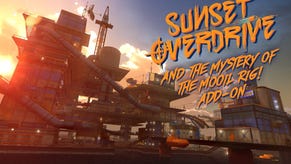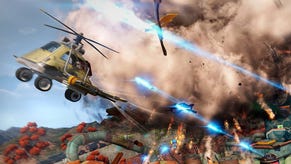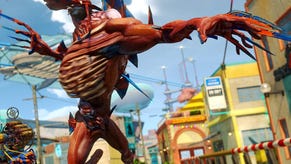How Insomniac's Sunset Overdrive mixes gunplay with rail-grinds
And why the Xbox One exclusive is more Jet Set Radio than Gears of War.
The walls of Insomniac Games' LA office reception area are lined with magazine covers depicting the firm's 20 year history. The dynamic duo of Ratchet and Clank peer down from a great many of the of them, while the less-cuddly, four-eyed Chimera of the Resistance series are plastered across others, and Spyro's smile is dotted throughout. All serve to celebrate Insomniac's past glories but they also represent successful franchises that Insomniac has created and developed but ultimately does not own.
A quick scan of the walls fails to turn up a cover depicting Fuse, the multi-format IP that does belong to Insomniac, but whose four-player co-op action so underwhelmed Eurogamer's Dan Whitehead when it was released last year that he bemoaned it as a game about which "...there is virtually nothing of interest to say".
Sunset Overdrive is shaping up to stand as the antithesis of this disheartening sentiment. Insomniac's second roll of the Create Your Own IP dice is an open-world third-person shooter that dispenses with the notion that the end of the world should sour anybody's mood. Instead, it sets out to embrace a scenario in which there are no laws to govern behaviour, no social norms to dictate personal appearance and no rules to prevent you from using the city as a giant playground. Fun in the end times is Sunset Overdrive's mission statement, and it's one it's so far living up to.
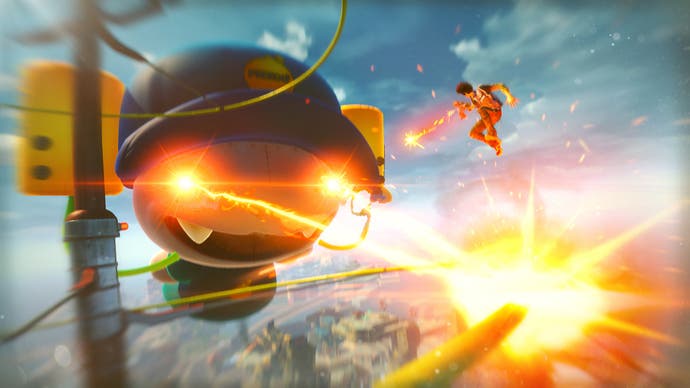
The deliberately goofy story tells of one Sunset City, which finds itself on lock-down due to the latest greed-driven misadventure of FizzCo. Unfortunately, the mega-corporation's Overcharge Delirium XT energy drink features side-effects that include rabid addiction, gross disfigurement and blind rage, which prompts the company to shut down the city and blame the mutated population - dubbed the OD'D - on a viral outbreak.
17 days later and you're still locked in there with them, along with several disparate groups of survivors. Rather than pine after days gone by, you embrace the carnage and discover that you're actually pretty good at this survival business. Consequently, you set out to find a solution to the fizzy-drink-induced problems currently facing humanity with a measure of style and panache.
This is facilitated in the most obvious sense by letting you customise your appearance based upon the choice of two genders, six races and a whole host of clothing, tattoos and body paints. In addition, you have access to a large, offbeat arsenal that befits Insomniac's previous achievements in this area and that includes such gems as the Captain Ahab harpoon gun and the adorably explosive TNTeddy.
Evidently, the entire game has its tongue planted firmly in its cheek. However, Insomniac's potential master stroke is that while Sunset Overdrive looks like so much chaos and lawlessness, it's actually predicated upon a series of very deliberate rules that leave very little to chance. By stripping back the basic concepts of traversal and combat, Insomniac has been able to intertwine the two from the ground-up to incorporate rail-grinding, wall-running and pole-swinging interspersed with bouncing on cars, awnings and parasols, often while fighting crowds of enemies.
"The focus on high-velocity traversal more readily calls to mind the likes of Tony Hawk's, Jet Set Radio and the Prince of Persia series' than it does any third-person shooter counterpart."
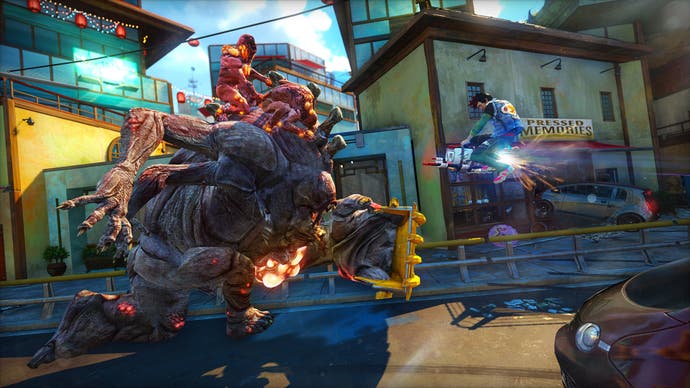
It's possible to move from one side of the city to the other without touching the ground, and this focus on high-velocity traversal more readily calls to mind the likes of Tony Hawk's, Jet Set Radio and the Prince of Persia series' than it does any third-person shooter counterpart. The clear visual language used to construct the city out of myriad grind-able edges level furniture promotes a sense of skill-based flow reminiscent of Roll7's 2D arcade skater, OlliOlli, only here the playground is an entire city that stretches into three-dimensional space.
A press of the X button is required to snap to the closest rail, wall or zip-line, which greatly reduces the potential for accidental parkour while also imbuing the traversal system with a sense of proactive impetus. It's not long before you've moved from grinding a rail and shooting a bad guy to conducting an entire boss battle hundreds of feet above ground while performing fluid tricks with the 'A to jump, X to land' combo that quickly becomes second nature.
Despite how fundamental a part of the experience it feels and the simple joy it elicits, this method of fluid traversal did not start as one of the core pillars of the game and has instead been worked in as part of the iterative design process.
"When we started as pre-production, traversal was not envisioned as part of the game. Instead, we spent a lot of time talking about the mood and about how we want players to feel," remembers creative co-director Drew Murray. "I want it to sound like Iggy Pop's Search and Destroy, that's the feeling that I want players to have while they're playing the game and moving through the world."
"It was Cameron [Christian, lead designer] who really pushed for that notion of having something that's easy to jump into but that holds a sense of mastery," adds Marcus Smith, who conceived of the Sunset Overdrive concept alongside Drew Murray.

Cameron Christian is the man responsible for keeping in check the high degree of order that's facilitating all of the chaos. Christian is responsible for the toolset and measuring tools that ensure that the city is built in modular 4x4 blocks, that no surface is angled between 26 and 45 degrees (so as to avoid doubt about whether you'll run or slide down it) and that the city's tiered structure facilitates an easily readable progression system.
"We want to encourage people to experiment and not be penalised for trying crazy stuff even when they're up high, because it really sucks when you've worked your way to the top of a building and then you fall down and have to start again," Christian explains.
"So, we created a system to mitigate by going with a tiered playground approach that ramps up in difficulty as you get higher. The first level is basic, easy traversal with long lines and easy bounces so a new player can approach that and get going right away. As you move up it gets more difficult and the highest level has a lot more wall-runs and need for vision and skill."
It's this coherence that helps Sunset City become the very definition of a virtual playground. While story missions, side-quests and bite-sized challenges are designed to keep you entertained, there's pleasure to be found in simply running amok and fighting the OD'D, NPC human enemies and FizzCo's robotic security forces. However, combining two systems has not been without its own challenges.
"When we first started out, combat and traversal were two separate things," says Christian. "Traversal was really used as a defensive measure but that didn't last long once we discovered that shooting while grinding was fun.
"The coherence helps Sunset City become the very definition of a virtual playground."
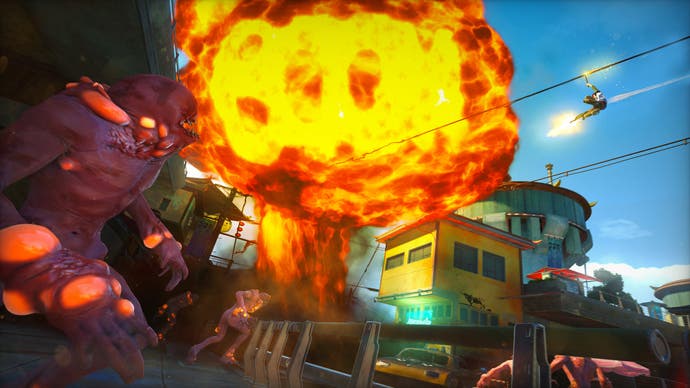
"We were scared that it would be a lot to take in and once we started mixing the two we had to adjust some of our world-building rules. So, 8m grinds are the minimum and in combat-heavy areas we have to make sure the grinds stretch a lot longer so that the player has time to shoot a dude and readjust to look for the next traversal option."
On the surface, the notion of rules, toolsets and calculated city formation doesn't seem to fit with Sunset Overdrive's garish tone, saturated colour palette and outlandish fiction. However, it's the consistency and coherence that such order brings that is allowing its key components to offer the feeling of effortless fun. The depth of its progression systems and the role of online multiplayer are yet to be explored and so there's a lot still up in the air, but Sunset Overdrive has nailed its basic mechanics. That's a positive start for a company hoping to progress beyond the mediocrity of last year's Fuse to establish a new IP that can grace the walls of its office alongside its more recognisable successes of the last 20 years.
On the way out of the office, I pass through the reception area again, only this time I'm not looking at the magazine covered walls. Instead, I'm assessing whether I could bounce from the sofa, to the reception desk and through the open door to the railings of the balcony beyond; Sunset Overdrive is on track to be that sort of game.
This article was based on a press trip to Insomniac's offices in Burbank, California. Microsoft paid for travel and accommodation.
